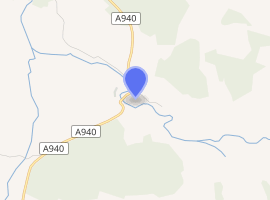Edinkillie House
Edinkillie House is a country house in Edinkillie in Moray, Scotland, built in 1822–1823 by John Paterson as a manse for the nearby Edinkillie Church. It has been designated a Category A listed building.
| Edinkillie House | |
|---|---|
.jpg) | |

| |
| General information | |
| Architectural style | Georgian |
| Town or city | Edinkillie, near Forres |
| Country | Scotland |
| Construction started | 1822 |
| Completed | 1823 |
| Design and construction | |
| Architect | John Paterson |
| Designations | Category A listed building[1] |
Description
Edinkillie House is a Georgian house, built in a Y-plan around a central south-facing bay in the shape of a half-octagon.[1][2] Two-storey wings, each with two bays, project from the centre, with single-storey, single-bay extensions beyond them.[3] The house presents large twelve-pane classical windows,[1][4] and is harled with tooled ashlar detailing.
History
Edinkillie House was built by John Paterson in 1822–1823, originally as the manse for Edinkillie Church. Its design was based upon plans that Paterson had unsuccessfully submitted for the construction of Dunphail House.[3][5] A porch, with rustic columns, was added in 1902 by John Wittet,[3] who may have done further work on the building in 1911.[6] The building was designated a Category B listed building in 1971, and was upgraded to Category A in 1987.[1]
References
- Historic Environment Scotland. "Edinkillie House (Former Edinkillie Church of Scotlad Mase) (Category A) (LB2188)". Retrieved 7 July 2019.
- "Edinkillie House". CANMORE. Historic Environment Scotland. Retrieved 7 July 2019.
- Walker, David W.; Woodworth, Matthew (2015). The Buildings of Scotland - Aberdeenshire: North and Moray. New Haven: Yale University Press. p. 561. ISBN 9780300204285.
- McKean, Charles (1987). The District of Moray - An Illustrated Architectural Guide. Edinburgh: Scottish Academic Press and RIAC Publishing. pp. 49–50. ISBN 1873190484.
- "John Patterson". Dictionary of Scottish Architects. Retrieved 25 September 2019.
- "Edinkillie Manse". Dictionary of Scottish Architects. Retrieved 25 September 2019.